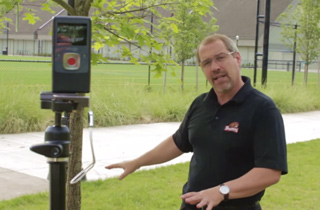Students got one-time skeptic hooked on online ed
Editor's note: This excerpt is taken from the March/April issue of "City Trees," the online magazine of the Society of Municipal Arborists.
By Paul D. Ries
Ecampus instructor
OSU College of Forestry
I also learned early in my career as an urban forester that if I wanted to be successful, I needed to be a teacher. Too many of the people I dealt with didn’t understand or appreciate trees, and urban forestry seemed like an oxymoron to far too many people. The green industry people I met often meant well, but many of them lacked practical urban forestry knowledge. Hence, I became an educator.

Urban forestry instructor Paul Ries posts weekly video demonstrations and interviews with experts for his Ecampus students.
I began by teaching courses for my local ISA chapter, state urban forestry council, and eventually SMA. After 20 years teaching adults, I was invited by Oregon State University (OSU) to become an affiliate faculty member and make occasional guest lectures in forestry and horticulture courses. A couple of successful one-credit seminar courses followed, and eventually I was asked to develop an online introductory urban forestry course for OSU Ecampus. That led to an advanced urban forest planning policy and management class and an arboriculture class – again online. Today, we offer a B.S. in Natural Resources with an Urban Forest Landscapes option with all courses online.
In the past four years I’ve taught almost 300 students in most U.S. states and Canadian provinces as well as students in Scotland, Brazil, Ecuador, the Bahamas, Puerto Rico, Taiwan, and even a U.S. soldier stationed in Afghanistan. I suppose I was as skeptical as anyone at first when thinking about offering entire college courses at a distance, but the enthusiasm of my students soon got me hooked. Teaching online courses has made me a better teacher, and my student discussions are actually more robust online than they were in my classroom. OSU Professional and Noncredit Education will eventually be launching some online urban forestry courses for continuing education credit as well. Now I’m teaching a full 25% of my work time.
Learning online takes a different type of self-discipline. Students must have a certain amount of computer literacy, but more important they need an intellectual curiosity coupled with a motivated attitude to see a course through from start to finish in 10 weeks. Online education is growing at a phenomenal rate – 17% per year, compared with only 2% in the resident instruction setting. One in four college students today has taken an online course. And distance educational delivery is a great equalizer – it extends access to higher education to people in remote locations or to those who have full-time jobs they can’t leave to attend college.
My students are quite diverse – some are finishing a degree they started years ago, while others have migrated into urban forestry from some other job area and are using my courses to strengthen their credentials. For a few, my course has been their employee orientation to an urban forestry position!
Given the pace of technological change in our society, it is only natural that learning would move online. Urban forestry is no exception—and I expect to see more and more online urban forestry education opportunities in the years to come.
– Paul D. Ries, Instructor & Extension Specialist – Urban Forestry, Oregon State University College of Forestry
Features and Navigation
Academic calendar
Currently it's fall term. See academic calendar for our quarter term schedule.
Winter term starts Jan. 5, 2026.
Spring term starts March 30, 2026.

